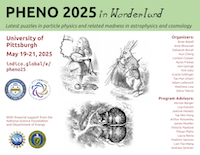Conveners
Gravitational Waves
- Sayan Mandal (Carnegie Mellon University)
Superradiance offers a unique link between particle and black hole physics. Through this process, a cloud of light particles can build up around a spinning black hole that resembles the hydrogen atom. If the black hole is part of a binary system, the cloud can be disrupted and the particles transition from one state of the atom to another. In this talk, I will analyze a new gravitational...
An accurate description of the scalar potential at finite temperature is crucial for studying cosmological first-order phase transitions (FOPT) in the early Universe. At finite temperatures, a precise treatment of thermal resummations is essential, as bosonic fields encounter significant infrared issues that can compromise standard perturbative approaches. The Partial Dressing (or the tadpole...
We construct the thermal bounce solution in holographic models that describes first-order phase transitions between the deconfined and confined phases in strongly-coupled gauge theories. This new, periodic Euclidean solution represents transitions that occur via thermally-assisted tunneling and interpolates between the $O(4)$-symmetric vacuum bubble at zero temperature and the high temperature...
In massive gravity, we expect a modification to the dispersion relation for gravitational waves and the angular correlation in pulsar timing arrays (PTAs) due to the five polarization modes that arise. We consider the lower bound for graviton mass constraints from the dispersion relation for future PTA observations and scrutinze the possibility of detection via the effective overlap reduction...
Recent observations from pulsar timing-array collaborations have provided compelling evidence for the existence of a stochastic gravitational wave background (SGWB). While astrophysical sources such as mergers of supermassive black hole binaries are likely contributors, additional signals may arise from early-universe phenomena or modified gravity theories. These different origins are expected...
The Galactic-Center Excess, a surplus of gamma rays at the Milky Way’s core, has sparked debate
over its origins, with two main theories suggesting either dark matter annihilation or emissions from mil-
lisecond pulsars as potential sources. This study utilizes data from the Laser Interferometer Gravitational-
Wave Observatory (LIGO) to explore the presence of millisecond pulsars in the...
We employ a gauge-invariant perturbative framework to analyze the next-to-leading order (NLO) effective action of the SU(2)-Higgs model at finite temperature. This involves utilizing a specific power counting scheme, which allows us to compute gauge-invariant observables for primordial gravitational waves arising from a thermal first-order electroweak phase transition. Finally, we then compare...
We investigate the non-zero temperature dynamics of a sub-GeV dark matter scenario
freezing-out via self-interactions. As a prototype, we take up the case of a scalar dark matter species undergoing $3 \to 2$ number changing annihilations catalysed by another scalar. We study the shape of the thermal potential of this scenario in a parameter region accounting for the observed relic abundance....

